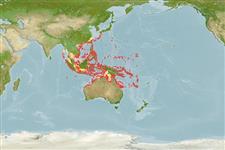Classification / Names
Common names from other countries
Issue
The spelling of the genus is C*h*romileptes in Eschmeyer (CofF ver. Mar. 2011: Ref. 86697). Although it is a logical change, it needs further inverstigations because of the general usage of C**romileptes.
Main reference
Size / Weight / Age
Max length : 70.0 cm TL male/unsexed; (Ref. 5222)
Length at first maturity
Lm ?, range 39 - ? cm
Environment
Marine; reef-associated; depth range 2 - 40 m (Ref. 9710), usually 5 - 25 m (Ref. 90102)
Climate / Range
Tropical, preferred ?; 32°N - 23°S, 88°E - 168°E (Ref. 5222)
Distribution
Western Pacific: southern Japan to Palau, Guam, New Caledonia and southern Queensland, Australia. Eastern Indian Ocean: Nicobar Islands to Broome, Western Australia. Reports from western Indian Ocean (Heemstra and Randall 1984, 1986, Ref. 3153 and 4319 respectively) are unsubstantiated, except one from Kenya (Smith 1954, Ref. 6514) which seems valid. Records from Hawaii are probably based on released aquarium fishes (Ref. 4787).
Countries | FAO areas | Ecosystems | Occurrences | Introductions
Short description
Dorsal
spines
(total): 10;
Dorsal
soft rays
(total): 17-19;
Anal
spines: 3;
Anal
soft rays: 9 - 10. This species is easily distinguished by its extreme smallness of size of the anterior part of the head as compared to the elevated postorbital part; absence of canine teeth, except for a very small pair at the front of the upper jaw; D X, 17-19; A III, 10 (rarely 9); a slit-like posterior nostril; color greenish white to light greenish brown with scattered round black spots on head, body, and fins, with body spots generally larger than those on head and fins; about 9 large roundish dusky blotches may be present on body, with some extending partly into base of dorsal and anal fins (Ref. 5222); characterized further by having moderately deep body, greatest depth 2.5-3.0 in SL; small eyes; concave dorsal profile of head; rounded caudal fin (Ref. 90102).
IUCN Red List Status (Ref. 115185)
Threat to humans
Harmless
Human uses
Fisheries: commercial; aquaculture: commercial; aquarium: commercial
Tools
Special reports
Download XML
Internet sources
Estimates of some properties based on models
Phylogenetic diversity index
PD50 = 1.0000 many relatives (e.g. carps) 0.5 - 2.0 few relatives (e.g. lungfishes)
Trophic Level
4.5 ±0.80 se; Based on food items.
Resilience
Medium, minimum population doubling time 1.4 - 4.4 years (Preliminary K or Fecundity.)
Vulnerability
Low to moderate vulnerability (34 of 100)
Price category
